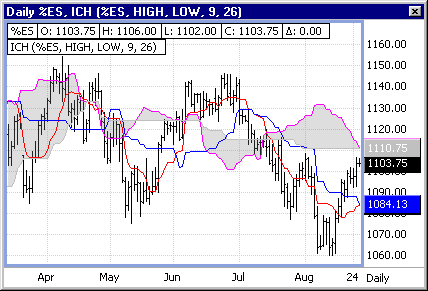
NOTE: The Ichimoku Study comes in two forms within FutureSource Workstation.
The First form comes as three separate studies:
Ichimoku1 - ICH1 - Tenkan and Kijun
Ichimoku2 - ICH2 - Senkou Span A, Senkou Span B, and Kumo
Ichimoku3 - ICH3 - Chikou line
The Second form is the original Ichimoku added to FutureSource Workstation. It has a study code of ICH. It is recommended that you use the new group of Ichimoku Studies (ICH1, ICH2, & ICH3) as they project the Senkou Span A, Senkou Span B, and Komo into the future, where as the original Ichimoku does not project into the future.
The Ichimoku study is a trend-following indicator that identifies support and resistance levels and generates trading signals in a way similar to moving averages. A key difference between moving averages and Ichimoku charts is that Ichimoku chart lines are shifted forward in time. This creates wider support and resistance zones and decreases the risk of trading false breakouts.
Pane: Overlay
Calculation
The Ichimoku study conveys a great deal of information on trend existence, direction, support and resistance. It comprises four main lines:
Ichimoku1 - ICH1
Turning Line (Tenkan) = (Highest High + Lowest Low) / 2, for the past 9 days
Standard Line (Kijun) = (Highest High + Lowest Low) / 2, for the past 26 days
Ichimoku2 - ICH2 - Leading lines
Leading Span 1 (Senkou span 1) = (Standard Line + Turning Line) / 2, plotted 26 days ahead of today
Leading Span 2 (Senkou span 2) = (Highest High + Lowest Low) / 2, for the past 52 days, plotted 26 days ahead of today
Band (Kumo) = Area between the above Spans.
Ichimoku3 - ICH3 - Lagging line
Chikou = The closing price, time-shifted backwards by 26 periods.
Properties
Period1: The number of bars of the first Line. If the chart displays daily data, then period denotes days; in weekly charts, the period will stand for weeks, and so on. If the default length of the indicator is chosen (Workstation uses a period of 9), the study will return the average of the highest of the high price values / lowest of the low price values over the previous 9 bars.
Period2: The number of bars of the second Line. If the chart displays daily data, then period denotes days; in weekly charts, the period will stand for weeks, and so on. If the default length of the indicator is chosen (Workstation uses a period of 26), the study will return the average of the highest of the high price values / lowest of the low price values over the previous 26 bars.
Interpretation
Much like a moving average crossover strategy, Ichimoku charts generate a buy signal when the Turning Line crosses the Standard Line from below. They generate a sell signal when the Turning Line crosses the Standard Line from above.
Additionally, the shaded area that is formed between Leading Spans 1 and 2 is known as a cloud and defines support or resistance. Clouds not only act as support or resistance, they also help to identify trend direction. When prices are above the cloud, the trend is up. Similarly, when prices are below the cloud, the trend is likely down. Below is an example of an Ichimoku chart:
